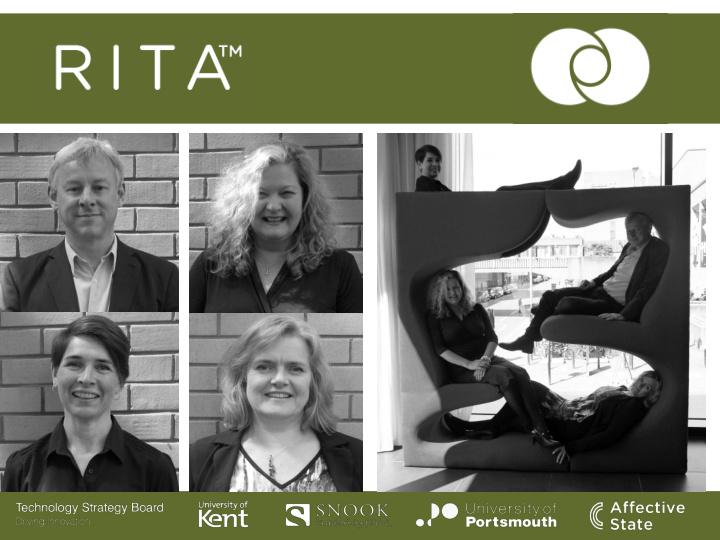



www.kent.ac.uk/sspssr/ccp
www.kent.ac.uk/sspssr/ccp
The aims of Project TM RITA Project Aims & Deliverables 1. To provide part of an innovative solution to the long term care revolution for older adults and to disrupt the current system 2. To work creatively as part of a inter-disciplinary team, working across boundaries to deliver a proof of concept for Rita 3. Carry out user testing on the concept of Rita 4. Build the face of Rita based upon research 5. Explore what we could build ‘under the bonnet’ of Rita and what existing provision we could possible incorporate into her design 6. Show a service provision vision for the future www.kent.ac.uk/sspssr/ccp
The Problem and the Long-term Care Revolution 1. Increased life expectancy with multiple complex conditions (Treggle 2012) 2. Significant focus on the increase of dementia (Older People Wales 2011) 3. NHS funding gap (Ramesh 2013) 4. Aspiration for individualised care and personal control (Cartwright 2007) 5. Community vs Residential & quality of life (Craig & Khaoury 2013) 6. Emphasis on good standards of personalised care (Manthorpe et al. 2007) “It would be important if RITA could coordinate health and social services and voluntary organisations to make sure people receive the help and support they need” (Alice, 66) www.kent.ac.uk/sspssr/ccp
‘ It’s personal for all of us’ “Relieving the burden of guilt on family of older people who need a lot of support. Knowing that she is being monitored but also that she is having some conversational stimulation through the day” (Gemma, 54) www.kent.ac.uk/sspssr/ccp
TM The Vision for RITA Radically changing service design www.kent.ac.uk/sspssr/ccp
Understanding the users of the future (us) What the people have told us they would & wouldn’t like Themes (from discussions with 180 people) 1. Memory prompts & access to past and present experiences 2. Connecting with others and reminiscing 3. Co-ordinating care and support 4. ‘Help me with the things I can’t do – but I want to be in control!’ 5. ‘Can I trust Rita?’ Data protection, ethics and technical issues ‘ Can Rita do smells?’ (Couple aged 56, 64) www.kent.ac.uk/sspssr/ccp www.kent.ac.uk/sspssr/ccp
TM Meet RITA 1. Realism or not? 2. The ‘Uncanny Valley’ theory (Mori 1970) 3. The face was designed based on research which indicated trustworthiness and honesty 4. The most attractive voice - Scottish www.kent.ac.uk/sspssr/ccp
TM can do Visualising what RITA To demonstrate the proposed functionality of Rita and how she could meet the often complex and different needs of individuals we have made two films: ‘George’ “Help me stay in touch with friends, have fun, enjoy life, not be an old person.” (Colin 59) ‘Mrs Jones’ - http://vimeo.com/105421063 “I would like to have the reminder system and all information in one place. Can also see how useful the monitoring system would be for relatives that are worried .” (Florrie 81) www.kent.ac.uk/sspssr/ccp
TM (about us)’ ‘Educating RITA Behind the face of RITA Audio Video Linguistic analysis Real-time Affective State estimation Context Empathy Engine assessment Affective Speech <tag> State Training identification Well-being Assessment Database search State Log Avatar Control www.kent.ac.uk/sspssr/ccp
The future ‘Proof of concept’ phase ending 1. 2. Next phases from ‘proof of concept’ to product design 3. From product design to service provision We are interested to talk with potential collaborators – visit our 4. stand, visit the website, talk to us…… J.Reeves@kent.ac.uk ‘Rita, Rita I want you’ (Roy Orbison) www.kent.ac.uk/sspssr/ccp
www.kent.ac.uk/sspssr/ccp
Recommend
More recommend